2022 FINA WORLD AQUATICS CHAMPIONSHIPS
- June 18-25, 2022 (pool swimming)
- Budapest, Hungary
- Duna Arena
- LCM (50-meter format)
- Meet Central
- Preview Index
- Full Aquatics Schedule
- How To Watch
- Psych Sheets
- Live Results
Click here to see all of our 2022 World Championship Previews.
By The Numbers:
- World Record: Great Britain (Kathleen Dawson, Adam Peaty, James Guy, Anna Hopkin) – 3:37.58 (2021)
- Championship Record: United States (Matt Grevers, Lily King, Caeleb Dressel, Simone Manuel) – 3:38.56 (2017)
- 2021 Olympic Champion: Great Britain (Kathleen Dawson, Adam Peaty, James Guy, Anna Hopkin) – 3:37.58
- 2019 World Champion: Australia (Mitch Larkin, Matthew Wilson, Emma McKeon, Cate Campbell) – 3:39.08
It is often said that the mixed medley relay is a coaches’ race and not a swimmers’ race. You must account for the specific swimmer, the gender of the swimmer, and what stroke they are swimming in order to decide the perfect lineup. For most countries, picking out the right swimmers in the right order is often more important than how fast the swimmers can actually go in the race.
The point made above was proven when last year, the United States had four of the best swimmers on the planet in Ryan Murphy, Lydia Jacoby, Torri Huske, and Caeleb Dressel, and still finished in fifth at the Olympics. All of those swimmers went fast times, but the lineup that they were put in screwed them over. If they had put in swimmers of different gender in different strokes, they could have had a shot at the podium.
This year, the mixed medley relay looks different from what it was in Tokyo. In the absence of Adam Peaty, Great Britain loses its X-factor that helped them win Olympic gold and break the world record. Kathleen Dawson, their backstroke leg, will also not be present in Budapest, leaving this team even more weak and vulnerable to losing their #1 ranking from last year. This means that another country will likely have to be the ones to step up and take the top position.
In this preview, we dive into what we believe will be the best lineups for each of the countries contending for medals in this relay. When we compare the aggregate times for each country, we took the fastest relay split (or flat start time, if they’ve been faster there) from the last two years for each swimmer, and then looked at what would be the fastest lineup that the nation could go with.
Front-End Fight
With a watered-down Great Britain team, the United States and China look to be the ones battling for the top position. Why? Because neither team has a stroke that is an obvious “glaring weakness” for them.
| Regan Smith – 57.64 | Back | Xu Jiayu – 52.51 |
| Michael Andrew – 58.14 | Breast | Yan Zibei – 58.11 |
| Caeleb Dressel – 49.03 | Fly | Zhang Yufei – 55.39 |
| Torri Huske – 53.35 | Free | Yang Junxuan – 52.71 |
| 3:38.12 | Total | 3:38.72 |
On the legs where the two countries are using different gender swimmers, the Americans have the advantage. While Caeleb Dressel is a whole 6.36 seconds faster than Zhang Yufei, Xu Jiayu is only 5.13 seconds faster than Regan Smith. However, this gap evens out when they have a male/male or female/female head to head. The gap between Michael Andrew and Yan Zibei is only 0.03 seconds, but Yang Junxuan is 0.64 seconds faster than Torri Huske. That doesn’t fully mitigate the advantage that Dressel has, but it’s going to make the race a lot closer, and one small mistake could turn the race in China’s favor.
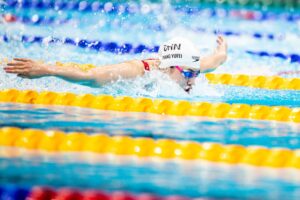
Zhang Yufei (photo: Jack Spitser)
Still, I think the United States has a bigger upside over China in this race. Yes, many swimmers on both teams have to deal with session doubles/triples, such as Dressel with the 100 free semis, Smith and Zhang with the 200 fly semis (and then the 50 back semis for Smith as well), Andrew and Yan with the 50 breast final, and Yang with the 200 free final. However, the United States has the depth to use completely different swimmers in prelims, whereas China does not.
Last year at the Olympics, China used the exact same swimmers in prelims that they did during finals. That ended up working well for them, as they eventually came home with the silver medal. However, the prelims of the mixed medley relay were two days before the finals last year. This year, they are on the same day, which means more racing in a shorter time and greater chance of burnout. China has 1:05.63 breaststroker Yu Jingyao and 51.65 butterflier Wang Changhao to replace Yan and Zhang respectively, and a few 53-mid 100 freestylers like Zhu Menghui to replace Yang in prelims, but using them in a situation like this would be a gamble. In addition, while Dressel is dominant over the rest of the field on butterfly, there’s really nobody on the Chinese team that has that type of effect.
What the Americans need to do to secure this victory is not slip up in any way possible. And that might not be very easy, which gives China many opportunities to sneak upon them.
On paper, Smith-Andrew-Dressel-Huske is the best option. With Nic Fink and Michael Andrew both being able to go 58-low, using a male breaststroker is the clear choice, and it’s just a matter of who’s performing better come time for the race. However, the other three legs might not be as easy to decide.
How much energy Smith has come time for this relay after her 50 back and 200 fly semis could potentially decide the outcome of this race. Historically, she’s done really well with multi-event sessions, most notably when she won the 200 back at NCAAs and then proceeded to finish second in the 200 fly minutes after. So if she’s in shape to swim one more 100 back, then that’s great. However, if she isn’t, the U.S. either has to turn to Claire Curzan to replace her, or pick a male backstroker like Murphy or Hunter Armstrong. The latter situation isn’t ideal, as that means they would have to give up Caeleb Dressel, the best sprinter in the world, or use Lilly King on breaststroke (being the only team with a female breastroker put the U.S. at a major disadvantage last year, so that wouldn’t be a good option either).
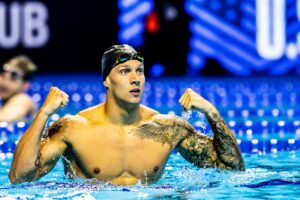
Caeleb Dressel (photo: Jack Spitser)
Then, they’ve got the back-end dilemma. We learned last year that using Dressel as an anchor isn’t a good idea, as even with a 46.99 split, he was way too far behind the likes of Emma McKeon and Anna Hopkin to run them down. If he was to carry the Americans to victory, he would have to be even faster than Jason Lezak was on the Beijing 4×100 free relay, which is unrealistic to expect even out of someone like Dressel. So given that he has three of the fastest fly splits in history, having him swim that stroke would be a much better use of his talent. But then we have to consider America’s biggest weakness: women’s sprint freestyle. At 53.35, their fastest sprinter this year is Torri Huske. She hasn’t swum the 100 free off a relay start at a major senior international meet before, so I could see her going anywhere from 53.5 to 52.5. If she ends up clocking a split on the slower end, she likely won’t be able to match the pace of the other freestylers (who will most likely be female) in the field. Dressel’s abilities to go 49-low on fly will likely mitigate this freestyle deficit, but if he’s off form, the Americans could be in danger.
That being said, with Dressel’s dominance and most likely not having to recycle swimmers between prelims and finals, the United States is the slight favorite in this race. However, it’s going to be a much tighter race with China than it seems.
Australia: Without Their Best, Can They Prevail?
| Kaylee McKeown | 57.45 |
| Zac Stubblety-Cook | 58.67 |
| Matt Temple | 50.26 |
| Mollie O’Callaghan | 52.35 |
| Total | 3:38.73 |
In 2019, the Australians won this title largely by virtue of Cate Campbell’s astronomical 51.10 freestyle leg. The reason why I don’t have them in the same category as the United States and China in this article is because of the inconsistencies of the Australian men, and because their two best female freestylers, Emma McKeon and Cate Campbell, won’t be at Worlds.
Like China, the Aussies have a pretty straightforward best lineup, with Kaylee McKeown on back, Zac Stubblety-Cook on breast, Matt Temple on fly, and Mollie O’Callaghan on free. That’s almost identical to their bronze-medal-winning lineup from last year, aside from the absence of McKeon on free. However, a good portion of this lineup looks faster than it seems.
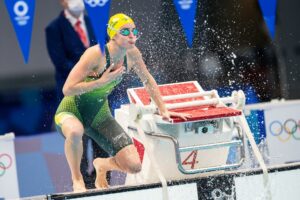
Kaylee McKeown (photo: Jack Spitser)
While McKeown is the world record holder in the women’s 100 back, she’s never been sub-58 on a relay before, which could potentially add half a second to her country’s aggregate time. Similarly, even though Zac Stubblety-Cook split 58-point twice in Tokyo, his flat start best time of 59.60 in the 100 breast (which, keep in mind, came just a day after breaking the world record in the 200 breast this year) doesn’t bode very well for him. In addition, Stubblety-Cook also wasn’t able to break a minute individually in the 100 breast at the Olympics, so expecting him to throw down another 58.67 split would be risky. Matt Temple’s season-best time is 51.50, over a second off his fastest split of 50.26, but he’s been near his best more often than Stubblety-Cook for me to trust that he can go at least 50-mid again.
The only portion of this relay that I can see getting faster than slower is the freestyle leg. While O’Callaghan doesn’t have the crazy 51-low anchoring antics that McKeon and Campbell have, the ceiling for her is extremely high. She split 52.35 in the prelims of the women’s medley relay in Tokyo, and just went 52.49 individually this year. At just 18 years old, the possibilities for O’Callaghan are endless. She will likely help drive her teammates to a medal, but I don’t think it will be enough for gold considering the weaknesses of the rest of her team.
If everyone on this Australian squad is at their best, then they could have a shot at being right up there with the U.S. and China. However, there’s a good chance that we see them gaining at least a one-second deficit due to mishaps.
On The Fringe
Italy
| Back | Thomas Ceccon – 52.30 |
| Breast | Nicolo Martinenghi – 57.84 |
| Fly | Elena Di Liddo – 56.62 |
| Free | Silvia Di Pietro – 53.84 |
| Total | 3:40.60 |
The retirement of Federica Pellegrini, who anchored Italy’s Tokyo fourth-place relay in 52.70, is a huge blow for this squad. When you replace her with Silvia Di Pietro’s best relay split, this team is over a second slower than their time from last year. And considering that Di Pietro has only been sub-54 on a relay once, the disadvantage is even bigger.
Italy has two world-class female breaststrokers in Arianna Castiglioni and world record holder Benedetta Pilato, but if you swap Nicolo Martinenghi with Castiglioni’s fastest split of 1:05.26 and Di Pietro with Alessandro Miressi’s fastest split of 47.21, you get an aggregate time of 7:41.39. That’s slower than their best-possible lineup (which once again proves that you need to use a male breaststroker on this relay), so they probably won’t use it unless Di Pietro is really off form. That being said, although Italy doesn’t have the horsepower to get on the podium, they are likely a lock for the final.
Great Britain
| Back | Medi Harris – 59.24 |
| Breast | James Wilby – 58.58 |
| Fly | James Guy – 50.00 |
| Free | Anna Hopkin – 52.00 |
| Total | 3:39.82 |
Even with Dawson and Peaty absent, the female-male-male-female lineup is still going to be the fastest for the Brits. Largely due to the splits from James Guy and Anna Hopkin on the world record relay last year, Great Britain’s aggregate time is still relatively competitive with the rest of the field despite being nearly three seconds slower.
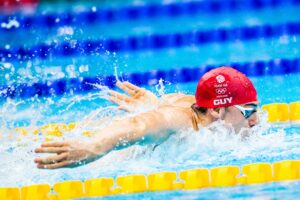
James Guy (photo: Jack Spitser)
We know what Guy and Hopkin are capable of, so this race for the Brits is up to whether Medi Harris and James Wilby can step up or not. Harris is in the midst of a breakout season, having broken a minute for the first time earlier this year. That essentially catapults her into the position of Great Britain’s top female backstroker without Dawson, so the pressure will be on her at her first major international meet. Wilby, on the other hand, has played second fiddle to Peaty in the 100 breast for years, and will be swimming on his first finals relay in a long time.
Without their biggest stars, repeating gold is a long shot for Great Britain. However, they still have half of their world record relay, and two other swimmers that could potentially break out on the biggest stage.
Canada
| Back | Kylie Masse – 57.70 |
| Breast | James Dergousoff – 1:00.88 |
| Fly | Maggie MacNeil – 55.27 |
| Free | Josh Liendo – 47.51 |
| Total | 3:41.35 |
NOTE: Yuri Kisil actually had a faster free split (47.15) in Tokyo than Liendo did. However, we didn’t put him in because he was off form at trials and didn’t even qualify for the 100 free individually, and Liendo on the rise to become Canada’s best male sprinter.
Last year, Canada clearly did not focus on this relay, as they didn’t put their strongest swimmers in the Tokyo prelims and failed to make the final. However, if they go all in this year, they are definitely in the mix to finish top 8.
The biggest disadvantage that Canada has is its lack of a strong male breaststroker. Gabe Mastromatteo, who split 59.67 in Tokyo on the men’s medley relay, is not on Canada’s squad this year. Instead, their best breaststroker is James Dergousoff, who has a best time of 1:00.88. Dergousoff isn’t as fast as many of the other breastrokers in the field, but using him is still Canada’s fastest option.
While Masse-Dergoushoff-MacNeil-Liendo will produce the fastest results for Canda, putting Liendo on fly (50.88) and Penny Oleksiak on free (52.26) gives an aggregate time of 3:41.72, which is just 0.4 seconds off the quickest combination. Since Maggie MacNeil is just coming off a shoulder injury, she might not be at her best come time for Worlds. And in that case, this alternative lineup would be the right way to go about things.
Don’t Forget About….
Netherlands
| Kira Toussaint | 58.65 |
| Arno Kamminga | 57.80 |
| Nyls Korstanje | 51.34 |
| Marrit Steenbergen | 53.95 |
| Total | 3:41.74 |
The Dutch will also be seriously affected by recent retirements. Without Ranomi Kromowidjojo and Femke Heemskerk, they lose their best female freestylers from last year. Their fastest possible lineup is nearly half a second slower than what they went in Tokyo to finish sixth, and that was even with Toussaint being significantly slower than her best time.
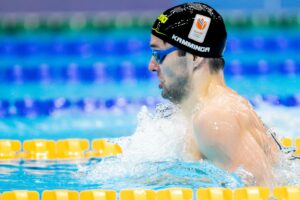
Arno Kamminga (photo: Jack Spitser)
That being said, this is yet again another squad that looks much faster on paper than they really should be. While Toussaint went 58.65 in the 100 back last year, she hasn’t been near that mark since. Her season-best time is 59.95, which adds over a second to the aggregate time of the Dutch.
However, a fast split from Arno Kamminga, the best breaststroker in the world in the absence of Peaty, as well as Nyls Korstanje and Marrit Steenbergen being near their best can put the Dutch in the final again.
Other countries contending for the finals are Germany and Israel. However, both squads are heavily weakened by the loss of many of their stars. Israel returns Anastasia Gorbenko, Gal Cohen Groumi, and Itay Goldfaden from their eighth-place finishing relay last year, but their strongest female freestyler Andrea Murez is gone. Daria Golovaty is entered in the women’s 100 free with a best time of 55.60, but she’s going to have to be faster than that to help Israel reach the final again. Similarly, while Germany has breakout stars in Rafael Miroslaw and Anna Elendt, they lack a second strong female swimmer to boost them to the top.
SwimSwam’s Picks
| Rank | Country | Tokyo Finish |
| 1 | United States | 5 |
| 2 | China | 2 |
| 3 | Australia | 3 |
| 4 | Great Britain | 1 |
| 5 | Italy | 5 |
| 6 | Canada | 13 |
| 7 | Netherlands | 6 |
| 8 | Israel | 8 |
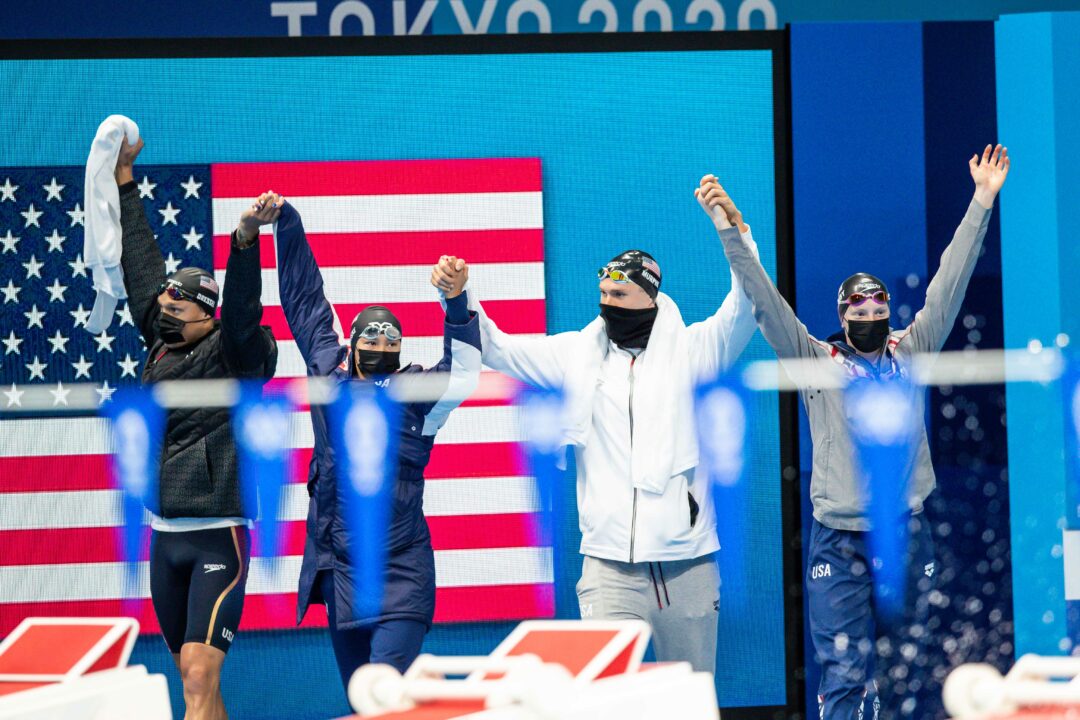
Team USA has few weaknesses, but the women’s 100 free is a big one.
It’s not going to hurt in the mixed medley relay. Gold virtually guaranteed.
It’s going to kill them in the women’s free relay. Gold: no way.
It will make or break them mixed free relay. Gold: maybe yes, maybe no.
On paper, given their depth and spread of talent, this one should be a “gimme” every time round for USA but for the past 4 years, they’ve somehow managed to make a GMBU of their line-up at every major outing.
Sooner or later, they are going to get it right and with GBR hamstrung by major absences; this is a gild edged opportunity.
CHN can, conceivably, make it close but probably need all the cards falling their way.
Likewise with AUS if even moreso as regards cards or planetary alignment.
GBR are not out of the medal picture but would really need all four legs swimming out of their skins.
ITA female legs most likely torpedo their chances… Read more »
It Huske delivers a 52 split like she should be able to (time in article is flat start) the US has a 1 second buffer against China and there’s also potential to turn the US’s 58 breakstroke split into a 57 high (hopefully they’ll use Finke). If The US executes properly China won’t be them.
*won’t beat them
Hopefully these coaches aren’t deer in headlights
Like the Tokyo group…they really messed up mixed medley and almost historic miscalculation on men’s medley that turned out …
King only ever really makes sense on this relay if she’s in 1:04low form, like 2017. Otherwise it’s just giving up too much elsewhere.
Does it ever make sense to use a female on the breast stroke? The Top4 at the last Olympics and WCs used a male…..
USA won this relay in 2017 and got second in 2019 with Lily King. But aside from them, I haven’t seen any other team be successful with one. That being said, in both of those instances, they used Dressel on fly and not free.
It could, but it’s the leg that generally makes the least sense. It’s the longest leg by time, so generally the gap between men and women is largest. It’s the inverse of the reason no one ever puts a male on free, and why the US relay got smoked so bad last year.
For each individual country those considerations might be different though, given the differences in times for their specific swimmers.
That relay was such an analytics nightmare for USA in Tokyo. Dressel or Huske time wise on free or fly is essentially a wash. The times are virtually identical w Huske at 55.6 and Dressel at 46.9. (3:18.28) Depends if you think Huske can hold the lead and have a nice drop into the 52’s or Dressel can reel em in with a faster relay split than his aforementioned mixed medley split.
Funny how the team 0.01 behind China’s projection is on next tier
I think you brought up some interesting points. I actually was thinking about the Dressel-Huske dilemma while writing this article, and I think it really comes down to the fact that I trust Dressel to go 49-low more than I trust Huske to split a best time (she’s never been sub-56 on a relay before), and that’s why Dressel on fly and Huske on free is prob still a better option. But if Dressel somehow has a really bad off day and Huske is on her A-game, I could see why someone would advocate for them to be swapped.
About Australia, I already explained this in the article, but their times on paper are faster than what I think they… Read more »
Regarding ZSC – he split 58 twice last year and looks even better this year. He should split roughly the same this year. Why would he be slower? You like to look at past relay splits and for ZSC they tell us he will split 58.
Where your logic on ZSC fails is that at the Olympics he was over 1 min in the flat start, but split 58 twice. At trials he was 59.60 flat start, and his 200 is faster. Absolutely no reason to think he won’t split 58 again on the relay.
What analytics? There was obviously no analytics involved in picking that lineup last year.
It was an NBC lineup